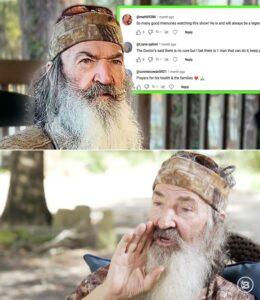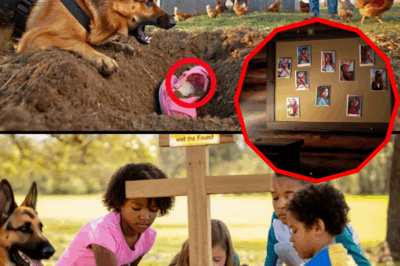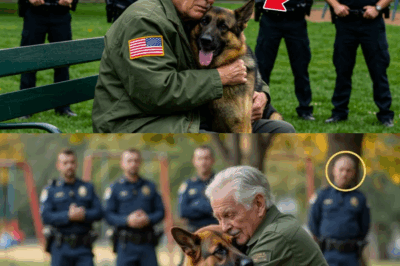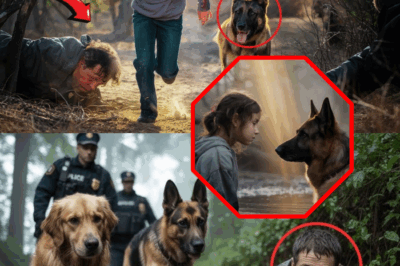Wounded K9 Drags Backpack to Police — The Miracle and the Mystery That Changed Everything
Thunder cracked over Cedar Grove as the rain poured in relentless torrents, pounding deserted streets into rivers of shimmering black glass. Officer Kelly Monroe was just locking up for the night, the comforting routine of paperwork and quiet coffee interrupted by a strange, sad shadow limping under the streetlight. At first, she thought it was a trick of the lightning—until she glimpsed sodden fur, blood, and sharp canine eyes brimming with exhaustion and intent.
It was a German Shepherd—clearly injured, its chest heaving as it pulled itself forward, teeth gripping a tattered, mud-caked backpack. Kelly didn’t hesitate. She flung open the station’s door, rain slashing inside, and watched as the dog collapsed at her feet in a puddle of blood and rain. The backpack dropped with a wet slap onto the tile.
A tense hush fell, broken only by a weak, impossible cry. A baby’s cry.

Within moments the station was chaos: officers with guns drawn, paramedics racing for supplies, and Kelly cradling a dirt-smeared, frigid baby girl—barely three months old—wrapped in nothing but a thin towel. Tears pooled on the floor. “She’s alive,” one officer sobbed. If they had been a little later, the doctors later said, she wouldn’t have made it.
But she had—and the mystery was only beginning.
In the corner, the dog—soon to be named Ryder—lay still, battered but ever watchful. He wasn’t some stray. Just three days before, his owner Officer Thomas Burke had reported him missing. Ryder was a retired K9, as disciplined and loyal as they come, haunted by years of service and loss. Burke himself was a quiet war veteran, now living alone in a cabin deep in the woods. Locals assumed the dog had finally run off or chased deer. Instead, Ryder was on a desperate mission.
By dawn, as rain quieted and dread set in, news arrived—no missing persons report matched the baby. They named her “Hope.” Ryder’s injuries—broken paw, cracked ribs, gaping gashes—painted a silent but vivid picture: this had not been an accident but a journey fraught with peril, a stubborn march to bring the child to help.
Officer Gina pored over missing cases and found a chilling lead: Maria Gonzalez, sixteen, last seen four months earlier. She’d been pregnant then, struggling through the foster care system after being kicked out of her home. Her last known contact: Thomas Burke, Ryder’s owner. Witnesses said Burke had offered her food and comfort at a soup kitchen. Was it compassion, or something darker?
Monroe drove out to Burke’s isolated cabin, heart pounding with dread and suspicion. The old man met her at the door, gray-bearded and tired—unfazed when she told him of the baby’s survival. He told her everything: Maria had come to him, terrified and begging for help. He’d tried to care for her, he insisted. But her sudden labor, the blood, her desperate final words asking him to protect her child—he’d panicked when Maria died, burying her quietly out back, then retreating into guilt and silence.

But Ryder would not let the story be buried. He broke out night after night, trying to rouse Burke, whining at a crawl space until, finally, he dragged the backpack—and baby Hope—toward town through storm, pain, and hunger.
Burke was taken into custody on charges of unlawful burial, child endangerment, and obstruction. Ryder, however, was hailed as a hero, featured in newspapers and local newscasts, his photo shared around the country. Still, that didn’t resolve the gnawing suspicion: how did Maria end up there? And, chillingly, was there more to the story?
Then, weeks later, the woods yielded new evidence: a hunter’s dog found a tarp with bloodied clothes, a disposable phone, and a bundle of girls’ letters hidden in a shallow grave. Among them, Maria’s diary revealed her fears—not only of her violent uncle but of Burke and the corrupt group home, the pattern of neglect and harm stretching back years. Her scrawled notes described Ryder guarding her door, barking when Burke came near, his devotion unyielding even as Maria’s trust faltered.
A deeper look into case files from neighboring counties began to reveal more missing girls, more letters, more secrets. Beneath Burke’s cabin itself, police found a hidden room with tally marks scraped into the walls and letters written by other frightened girls. When confronted by survivors and families in court, Burke was exposed as a predator hiding behind charity and small-town anonymity.
Through it all, Ryder’s loyalty never wavered. Recovered from his injuries, he was adopted by Diane, the nurse who saved Hope’s life, and who soon became Hope’s legal family. Ryder never sought medals or spotlights. He simply stood guard, sleeping by Hope’s crib, nuzzling her gently awake, his loyalty a shield against the memories of darkness.

Hope grew up with the story of Ryder, Maria, and the night that changed their lives—a story quietly retold at Cedar Grove’s playgrounds, in police training rooms, in the speeches of newly appointed Captain Monroe. A statue of Ryder, heroic and proud, now stands at City Park, a constant reminder that sometimes the most vital truths are carried not by voices, but by hearts—and by those who refuse to be silenced.
In the end, Ryder’s journey wasn’t just a race to save one child. It was a cry for help, a demand to be heard, and a lesson etched in sacrifice: listen, even when it hurts. And never ignore the silent devotion of those who walk beside us, no matter how battered or lost. Sometimes justice arrives not with sirens, but with a dog dragging hope through the rain.
Full video :
News
A Single Bark That Changed Everything: The Incredible True Story of a German Shepherd Who Unmasked a Hometown Serial Predator, Plunged a Quiet County into Nightmares, and Proved Some Heroes Will Risk It All to Protect the Innocent—Even When Evil Stares Back from the Darkness.
The Untold Story: How One Dog’s Loyalty Unmasked A Predator and Changed a Town Forever If not for Rocky’s bark…
Exposing the Unthinkable: K9 Hero Dog Uncovers Deadly Secret Agent Masquerading as Top Police Officer, Thrusting Entire Department into Heart-Stopping Conspiracy That Could Destroy Lives! Could Your Colleagues Be Impostors Too? Find Out What Shadow the Dog Saw That No Human Could Detect Before It Was Too Late!
K9 Hero Dog Detects Impostor in the Police Department — A Thrilling True Tale of Loyalty, Betrayal, and Instinct The…
A Missing Navy SEAL K9 Guarded a Mysterious Truck for Hours—When Commanders Forced Open the Door, What They Found Shattered Military Protocol and Exposed a Shocking Conspiracy That Had Haunted the Base for 18 Months, Sending Shockwaves Through the Special Operations Community and Changing History Forever.
K9 Dog Refused to Let the Navy SEAL Open His Truck Door—What Was Inside Made the Commander Step Back There…
Funeral Mayhem as German Shepherd Attacks Police Chief’s Casket—Dog Uncovers Shocking Secret, Forces Authorities to Exhume Coffin, Revealing Chief Still Breathing After Alleged Death, Setting Off Frenzied Hunt for a Would-Be Killer Among Trusted Colleagues, and Exposing an Explosive Scandal Shaking Local Government!
Article: The Dog That Wouldn’t Stop Barking – How Max Saved Chief Harrison, Unmasked a Conspiracy, and Shocked a Town…
Heroic War Dog Defies Police Orders and Recognizes His True Master After Thirty Years—Triggering a Midnight Siege, a Government Cover-Up, and a Fight to Protect a Bond Written in Blood and Battle!
A K9 Dog Was Ordered to Attack an Old Man — But What Happened Next Left Everyone in Tears! On…
The Incredible Sacrifice: How a Silent Girl and Her Broken-Down Retired Police Dog Stopped a Violent Crime and Changed a Whole Town’s Fate Forever—The Unbelievable Act of Loyalty That No One Saw Coming
Article: Silent Girl and Retired Police Dog Form Unbreakable Bond—What He Did to Save Her Shocked Everyone In a small…
End of content
No more pages to load


















